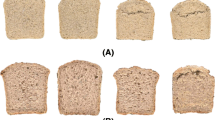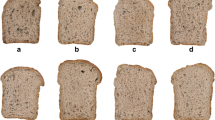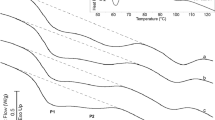Abstract
The significance of high hydrostatic pressure (HHP) processing on the physico-chemical—techno-functional and firming kinetics—parameters and nutritional properties—nutritional composition and “in vitro” starch digestibility—of highly replaced wheat flour breads by chickpea, pea and soybean flours was investigated, and the power/effectiveness of HHP in partially replacing structural agents (gluten and/or hydrocolloids) was discussed. Incorporation of pressured legume slurries (350 MPa, 10 min) at 42% of wheat replacement into bread formulation provoked a general increase in initial crumb hardness and browning of the crust with a concomitant explicit reduction of moisture, whiteness of the crumb and bread specific volume, but a slower in vitro starch digestibility with prominent formation of slowly digestible starch and resistant starch, compared to their counterparts prepared by using a conventional gluten/carboxymethyl cellulose (CMC)-added breadmaking recipe/process. Pressured breads with no gluten but 3% CMC in the formulation kept higher sensory ratings, softer initial texture and lower firming profiles on ageing than pressured breads with no gluten nor CMC. HHP has proven to be an effective technology to partially replace structuring agents (CMC and/or gluten) in high-legume wheat-based matrices providing sensorially acceptable breads with medium physico-chemical quality profile but enhanced formation of nutritionally relevant starch fractions and slower crumb firming kinetics on ageing.



Similar content being viewed by others
References
AACC (2005). Approved methods of the American Association of Cereal Chemists, AA CC. 10th edition, St. Paul, Minn.
Angioloni, A., & Collar, C. (2011). Physicochemical and nutritional properties of reduced-caloric density high-fibre breads. LWT - Food Science and Technology, 44, 747–758.
Angioloni, A., & Collar, C. (2012a). Effects of pressure treatment of hydrated oat, finger millet and sorghum flours on the quality and nutritional properties of composite wheat breads. Journal of Cereal Science, 56, 713–719.
Angioloni, A., & Collar, C. (2012b). High legume-wheat matrices: an alternative to promote bread nutritional value meeting dough viscoelastic restrictions. European Food Research and Technology, 234(2), 273–284.
Angioloni, A., & Collar, C. (2013). Impact of high hydrostatic pressure on protein aggregation and rheological properties of legume batters. Food and Bioprocess Technology, 6, 3576–3584.
AOAC. (1991). Total, soluble, and insoluble dietary fiber in foods. Association of Official Analytical Chemists.
AOAC. (2000). Official Methods of Analysis 17th Ed. AOAC International.
Armero, E., & Collar, C. (1998). Crumb firming kinetics of wheat breads with antistaling additives. Journal of Cereal Science, 28, 165–174.
Cauvain, S. P., Whitworth, M. B., & Alava, J. M. (1999). The evolution of bubble structure in bread doughs and its effect on bread structure. In G. M. Campbell, C. Webb, S. S. Pandiella, & K. Niranjan (Eds.), Bubbles in food (pp. 85–88). St. Paul, MN: Eagan Press.
Chung, H. J., Liu, Q., Hoover, R., Warkentin, T. D., & Vandenberg, B. (2008). In vitro starch digestibility, expected glycemic index, and thermal and pasting properties of flours from pea, lentil and chickpea cultivars. Food Chemistry, 111, 316–321.
Collar, C., Jiménez, T., Conte, P., & Fadda, C. (2014). Impact of ancient cereals, pseudocereals and legumes on starch hydrolysis and antiradical activity of technologically viable blended breads. Carbohydrate Polymers, 113, 149–158.
Englyst, K. N., Vinory, S., Englyst, H. N., & Lang, V. (2003). Glycaemic index of cereal products explained by their content of rapidly and slowly available glucose. British Journal of Nutrition, 89, 329–339.
European Commission (2006). Nutrition and health claims made in foods. Official Journal of European Commission L 404, 9–25.
FAO, 2016. http://www.fao.org/pulses-2016/en/.
FAO/WHO. (2003). Food energy—methods of analysis and conversion factors. Rome: FAO Food and Nutrition Paper 77.
Heremans, K., & Smeller, L. (1998). Protein structure and dynamics at high pressure. Biochimica et Biophysica Acta, 1386, 353–370.
Hsu, C. L., Chen, W., Weng, Y. M., & Tseng, C. Y. (2003). Chemical composition, physical properties, and antioxidant activities of yam flours as affected by different drying methods. Food Chemistry, 83, 85–89.
Hu, X. T., Xu, X. M., Jin, Z. Y., Tian, Y. Q., Bai, Y. X., & Xie, Z. J. (2011). Retrogradation properties of rice starch gelatinized by heat and high hydrostatic pressure (HHP). Journal of Food Engineering, 106, 262–266.
Hüttner, E. K., Dal Bello, F., Poutanen, K., & Arendt, E. K. (2009). Fundamental evaluation of the impact of high hydrostatic pressure on oat batters. Journal of Cereal Science, 49, 363–370.
ICC, 2014. ICC Standard Methods of the International Association for Cereal Chemistry. 104/1, 105/2, 110/1, 115/1, 136, 162, 166. The Association: Vienna. www.icc.or.at/standard_methods/001.
Jones, J. M. (2009). Nutrition: more on the GI debate. Cereal Foods World, 54(3), 138–140.
Kieffer, R., Schurer, F., Köhler, P., & Wieser, H. (2007). Effect of hydrostatic pressure and temperature on the chemical and functional properties of wheat gluten: studies on gluten, gliadin and glutenin. Journal of Cereal Science, 45, 285–292.
Knorr, D., Heinz, V., & Buckow, R. (2006). High pressure application for food biopolymers. Biochimica Biophysica Acta, 1764, 619–631.
Megazyme International Ireland (2011). Resistant starch assay procedure K-RSTAR
Megazyme International Ireland (2012). Total dietary fiber assay procedure K-TDFR-100A/K-TDFR-200A
Ramírez-Jiménez, A., Garcia-Villanova, B., & Guerra-Hernandez, E. (2001). Effect of toasting time on the browning of sliced bread. Journal of the Science of Food and Agriculture, 81(5), 513–518.
Scanlon, M. G., & Zghal, M. C. (2001). Bread properties and crumb structure. Food Research International, 34, 841–864.
Tharanathan, R. N., & Mahadevamma, S. (2003). Grain legumes-a boon to human nutrition. Trends in Food Science and Technology, 14, 507–518.
Tian, Y., Li, D., Zhao, J., Xu, X., & Jin, Z. (2014). Effect of high hydrostatic pressure (HHP) on slowly digestible properties of rice starches. Food Chemistry, 152, 225–229.
USDA (2015). Key elements of healthy eating patterns. In: Dietary guidelines for Americans 2015–2020. Eighth Edition. United States Department of Agriculture, p. 13–36.
Vallons, K. J. R., & Arendt, E. K. (2009). Effects of high pressure and temperature on the structural and rheological properties of sorghum starch. Innovative Food Science and Emerging Technologies, 10, 449–456.
Vallons, K. J. R., & Arendt, E. K. (2010). Understanding high pressure-induced changes in wheat flour–water suspensions using starch–gluten mixtures as model systems. Food Research International, 43, 893–901.
Vallons, K. J. R., Ryan, L. A. M., Koehler, P., & Arendt, E. K. (2010). High pressure-treated sorghum flour as a functional ingredient in the production of sorghum bread. European Food Research and Technology, 231, 711–717.
Vallons, K. J. R., Ryan, L. A. M., & Arendt, E. K. (2011). Promoting structure formation by high pressure in gluten-free flours. LWT-Food Science and Technology, 44, 1672–1680.
Vittadini, E., Clubbs, E., Shellhammer, T. H., & Vodovotz, Y. (2004). Effect of high pressure processing and addition of glycerol and salt on the properties of water in corn tortillas. Journal of Cereal Science, 39, 109–117.
Zhou, Z., Ren, X., Wang, F., Li, J., Si, X., Cao, R., Yang, R., Strappe, P., & Blanchard, C. (2015). High pressure processing manipulated buckwheat antioxidant activity, anti-adipogenic properties and starch digestibility. Journal of Cereal Science, 66, 31–36.
Acknowledgments
Authors gratefully acknowledge the financial support of the Consejo Superior de Investigaciones Científicas (CSIC), Ministerio de Economía y Competitividad (MINECO) and Fondo Europeo de Desarrollo Regional (MINECO/FEDER Project AGL2015-63849-C2-1-R).
Author information
Authors and Affiliations
Corresponding author
Rights and permissions
About this article
Cite this article
Collar, C., Angioloni, A. High-Legume Wheat-Based Matrices: Impact of High Pressure on Starch Hydrolysis and Firming Kinetics of Composite Breads. Food Bioprocess Technol 10, 1103–1112 (2017). https://doi.org/10.1007/s11947-017-1883-6
Received:
Accepted:
Published:
Issue Date:
DOI: https://doi.org/10.1007/s11947-017-1883-6




